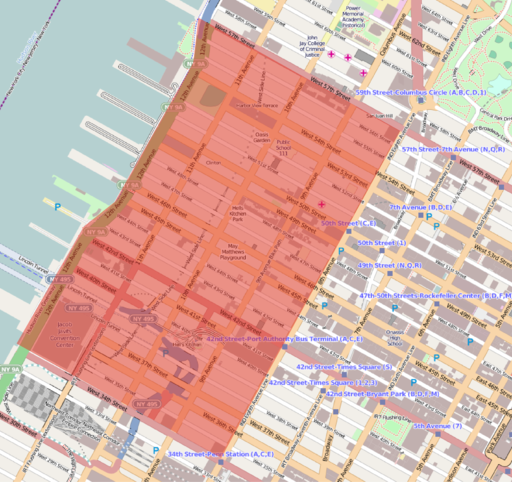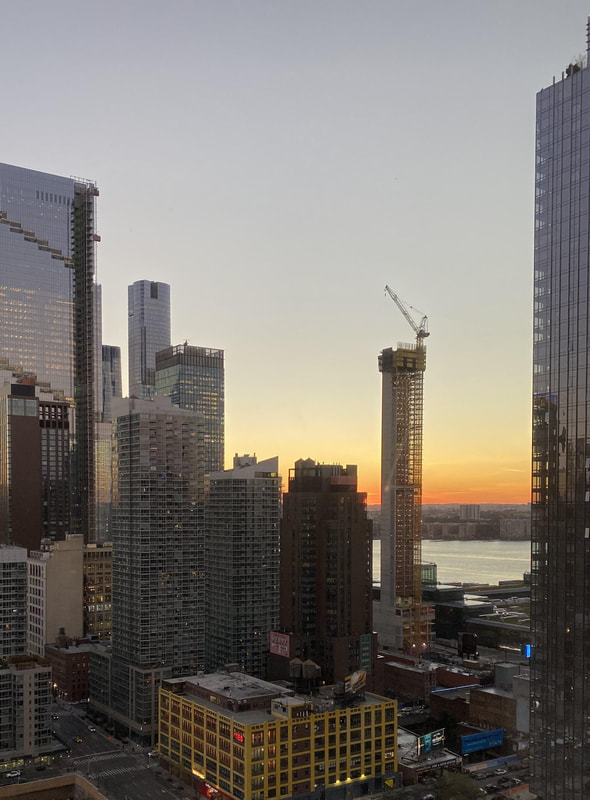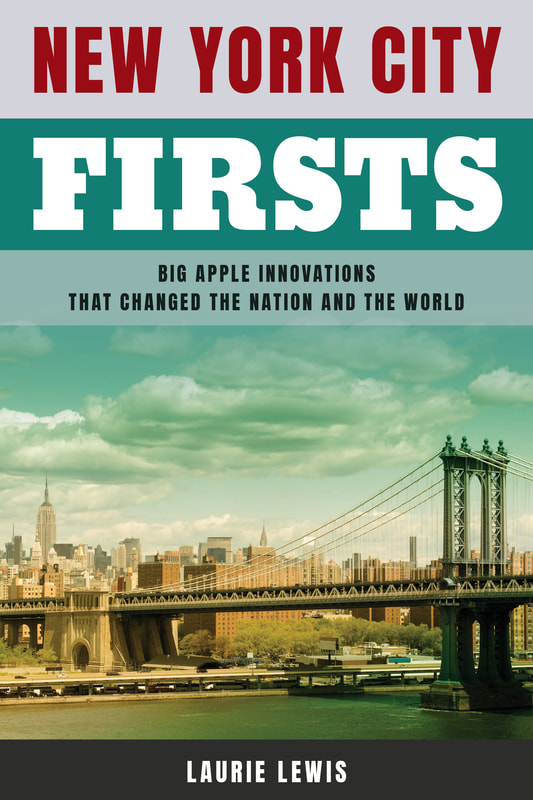|
By Laurie Lewis Hell’s Kitchen is a Manhattan neighborhood extending west of the Theater District all the way to the Hudson River; it lies between Chelsea to the south and the Upper West Side to the north. The most common explanation for this unflattering nickname is a conversation that supposedly took place between two policemen more than a century ago. One referred to the dangerous area as hell. The other suggested that hell was tame by comparison; this district was so crime-infested that it was hotter than hell, like hell’s kitchen. More genteel labels, including Clinton and Midtown West, have been suggested in the past fifty years, but the old name prevails. Hell's Kitchen, on the west side of Manhattan. Although this map shows it ending at 57th Street, 59th Street is usually considered the northern boundary. The Gritty Past Most early residents of the neighborhood were Irish immigrants who had fled the potato famine in the 1850s. They found jobs that required hard labor but offered little pay along the nearby Hudson River docks, railyards, slaughterhouses, tanneries, and factories. Crime was rampant in this poverty-stricken community ruled by rival gangs with colorful names like the Gophers (so called because they hid out in neighborhood cellars). The situation worsened as struggling members of other ethnic groups moved into the area. With Prohibition, the gangs found a new source of revenue: bootleg liquor. Gangland activity and racketeering in Hell’s Kitchen continued well past the Prohibition era. By 1965, the chief Irish gang was the Westies. After a long violent period, the Westies aligned with an Italian crime family, the Gambinos. It wasn’t mutual respect that brought these powerful rivals together. It was the desire to gain influence over trade unions and lucrative construction projects, like the Jacob Javits Convention Center at the southern end of Hell’s Kitchen. The Racketeer Influenced and Corrupt Organizations (RICO) Act eventually brought an end to the organized crime that had long plagued Hell’s Kitchen and had cemented its reputation as a dangerous place. The Era of Gentrification As early as the 1970s, the skyscape of Hell’s Kitchen began to change. The five- and six-story walk-ups that had housed generations of residents were joined by high-rise towers. Residential high-rises tower above older walk-up apartments in Hell's Kitchen The first residential high-rise was Manhattan Plaza, which was completed in 1977. Located between 42nd and 43rd Streets and Ninth and Tenth Avenues, the two forty-six–floor towers were originally intended to be upscale housing. When numerous roadblocks threatened to halt the project, plans changed. Most of the apartments, 70%, were earmarked for actors and other artists whose income level qualified them for subsidized housing. Among the now-famous residents in this group were Angela Lansbury, Samuel L. Jackson, Larry David, and Alicia Keys. The remaining apartments were split evenly between two groups who were already living in Hell’s Kitchen: people in subsidized housing and elderly and disabled residents. Waiting lists for these affordable apartments (by New York standards) have always been long. Meanwhile, other people who couldn’t find affordable apartments elsewhere in the city moved into the walk-ups of Hell’s Kitchen. Restaurants in all price ranges filled Ninth and Tenth Avenues. As the neighborhood became increasingly desirable, developers took their chances on the upscale housing that Manhattan Plaza was supposed to be, building more high-rise rentals and condos packed with amenities. The trend continues. According to a real estate website, large buildings added almost 3,200 apartments to Hell’s Kitchen between 2017 and 2021, accounting for 19% of all new apartments in New York City. The demographic make-up of Hell’s Kitchen is changing with the influx of new residents. Between 2010 and 2020, the white population decreased from 56.43% to 49.48%. At the same time, the Asian population increased from 15.01% to 20.18% and exceeded the number of Latinos. Hell’s Kitchen is no longer the impoverished community of the past. Another real estate website states that median household income there is $106,412. More than three-fourths of residents have a bachelor’s degree or higher. About half of Hell’s Kitchen residents are aged twenty-five to forty-four, and only 5% are children. The neighborhood is one of the most popular areas for LGBTQ New Yorkers. Hell’s Kitchen is one of the city’s hottest spots—but not the way it used to be. Six Weeks in Hell's Kitchen Toward the end of last year, I stayed in Hell’s Kitchen for six weeks while work was being done on my apartment. I didn’t know this part of the city well before making the move, and at times it felt so different that I had to remind myself I was still in New York. I find it difficult to describe the aura of Hell’s Kitchen. West of Eighth Avenue in the 40s, the artificial glitz of the Theater District gives way to what I imagine mid-twentieth–century middle-class New York might have been: generally well-maintained walk-up apartments occupied by people bustling about their business, but at a quieter pace. I especially felt this in the late afternoon, when I would see simply dressed residents on their way to what I envisioned as work in the nearby theaters. The main commercial drags, Ninth and Tenth Avenues, are always busy but less crowded on a weekday than business strips in some other residential areas. Most of the businesses are restaurants or places to buy food to eat at home. The food options are so numerous that, except for grocery stores, I never went to the same place twice during my six weeks in Hell’s Kitchen, despite having a lot of carryout and restaurant meals. I stayed in an apartment across from Manhattan Plaza. More than thirty floors above ground, I had views of the city that can be described in only one word: awesome. I don’t know which I enjoyed more: sunset over the Hudson or Midtown after dark. Views from a Hell's Kitchen high-rise The area west of Tenth Avenue is relatively undeveloped, although that is changing with the addition of more high-rises. Unlike the tall apartment buildings in the eastern half of Hell’s Kitchen, which seem well integrated into the neighborhood, the new structures farther west appear to be self-contained communities. Street life in this area is sparse, except for people walking dogs. In another ten or fifteen years, I suspect the entire area might be a seamless neighborhood, though not the gritty Hell’s Kitchen of years past. Be sure to get New York City Firsts: Big Apple Innovations That Changed the Nation and the World by Laurie Lewis. The book tells about more than 300 New York originals, like the safety pin, the Oreo, and the rock musical. New York City Firsts was selected as a finalist in the 19th annual Best Book Awards sponsored by American Book Fest. It is nominated for the 9th annual Apple Awards bestowed by the Guides Association of New York City (GANYC). Find out more about the book, including links to buy it, at www.nycfirsts.com. Tours We are no longer scheduling public tours that are open to anyone, but we are available for private tours. If you would like ideas for private tours, please see this website or email us at [email protected]. |
Archives
April 2024
|






